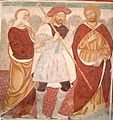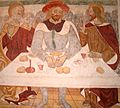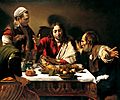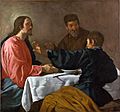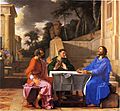Road to Emmaus appearance facts for kids
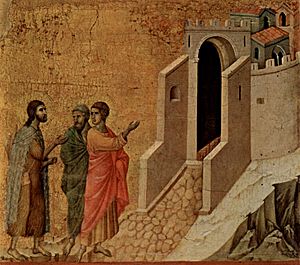
The road to Emmaus appearance is a famous story from the Gospel of Luke in the Bible. It tells how Jesus appeared to two of his followers after he was crucified and after his tomb was found empty. This event is one of the first times Jesus was seen after his resurrection. Both the meeting on the road and the meal Jesus shared with his followers in Emmaus have been popular subjects in art for centuries.
Contents
The Bible Story
The story of the Emmaus journey is one of the most detailed and well-written parts of the Gospel of Luke. It describes how Jesus met two of his followers on the road to Emmaus. One of the followers was named Cleopas. They were walking and talking about how sad they were about Jesus' death.
They didn't recognize Jesus at first. He looked like a stranger to them. They told him all about the sad events that had just happened in Jerusalem. They were so upset and confused.
As they walked, Jesus listened to them. Then, he started to explain things from the Scriptures. He showed them how everything that happened to him, including his suffering and death, was part of God's plan.
When they arrived in Emmaus, it was getting late. The two followers invited Jesus to stay and eat with them. They said, "Stay with us, for it is nearly evening." Jesus agreed and went inside to have supper with them.
What the Story Means
This story isn't just about proving that Jesus came back to life. It's also about how people can understand and recognize Jesus after his resurrection. It shows how the two followers slowly changed from being sad and confused to having strong faith.
The Emmaus story is seen as a guide for Christians. It helps them understand their own journey to a deeper faith. It also shows how they can help others grow in their faith too.
Similar Stories
The Gospel of Mark has a similar, shorter story. It says Jesus appeared to two followers while they were walking in the countryside. It doesn't name them or say they went to Emmaus.
Another story in the Bible, about the Ethiopian eunuch in the book of Acts, is also similar. In both stories, someone explains the Scriptures to help others understand Jesus. Both stories end with an important event: the breaking of bread at Emmaus and the baptism of the Ethiopian.
The Unnamed Follower
Many people have wondered who the second follower with Cleopas was. The Bible doesn't say their name. Some have suggested names like Simon, Nathanael, or even Luke the Evangelist himself.
Some experts believe that Luke didn't name the second follower on purpose. This might be to let the reader imagine themselves as that person. It's like the story invites you to join Cleopas on the journey.
The Journey Itself
As the two followers walked, they were deep in serious conversation. They were sad and confused. Jesus joined them, but they didn't know it was him. He seemed like a stranger.
One religious leader, Gregory the Great, explained why they didn't recognize Jesus. He said they loved Jesus but also doubted what had happened. So, Jesus was there, but he didn't show them his true identity right away.
Jesus let them share their worries and pain. He listened carefully as they talked about their doubts. He then used the Scriptures to help them understand why he had to suffer and be glorified. During this walk, Jesus gently guided them from feeling hopeless to feeling joyful. He wanted to strengthen their faith so they could truly see him when he broke the bread.
This "Emmaus Pilgrimage" can also help people when they are going through tough times. It reminds us that Jesus walks with us like a friend. He listens to our sadness and doubts and helps us heal inside.
"Stay with us"
When they reached Emmaus, Jesus acted like he was going to continue his journey. But the two followers strongly asked him to stay. They said, "Stay with us, for it is nearly evening; the day is almost over." So, Jesus went in to stay and eat with them.
By inviting the stranger (who was Jesus) to stay, the followers showed kindness and care. This openness allowed Jesus to change them deeply. Their hospitality helped them move past their sadness and confusion. This prepared them for the special moment when they would recognize Jesus at the table.
Supper at Emmaus
At first, the followers' eyes were "held," meaning they couldn't recognize Jesus. But later, when Jesus took bread, blessed it, broke it, and gave it to them, "their eyes were opened." They finally knew it was him!
Many people believe that this "breaking of bread" moment is like the Eucharist, a special meal in Christian churches. It's a way for Christians to feel close to Jesus.
Pope John Paul II said that when the followers asked Jesus to stay with them, Jesus responded by giving them a way to stay in him. This happens through the Eucharist, where people can have a deep connection with Jesus. Even though Jesus' physical face disappeared, he "stayed" with them, hidden in the "breaking of the bread."
Return to Jerusalem
The Bible says that the two followers' hearts were "burning" inside them while Jesus explained the Scriptures on the road. They had gone from feeling sad to feeling excited.
As soon as they recognized Jesus at supper, they immediately returned to Jerusalem. They wanted to share their amazing experience with the other followers. They felt a strong need to tell everyone the good news. John Paul II said that after connecting with Jesus at the meal, they realized they had a duty to share his message with the world.
In Art
Artists have often painted both the meeting on the road and the supper in Emmaus. The supper scene has been painted more often. In older art, from the Middle Ages, Jesus is sometimes shown wearing a big, floppy hat. This helped explain why the followers didn't recognize him at first. It was often a pilgrim's hat with special badges.
Since the Renaissance, the supper scene has been very popular. Artists often show the exact moment when the followers realize it's Jesus.
Rembrandt's painting of the supper from 1648 shows the followers surprised and amazed, but not scared. A servant in the painting doesn't even notice the special moment happening.
Caravaggio painted two famous versions of the Supper at Emmaus. Both paintings look very real, but some people criticized them. For example, Caravaggio painted Jesus without a beard, and in one painting, the fruit on the table was out of season.
Many other famous artists have also painted the Supper at Emmaus, including Jacopo Bassano, Titian, and Velázquez. The supper was even the subject of a very famous fake Vermeer painting by Han van Meegeren.
The Emmaus story has also appeared in poems and other writings since the 12th century.
Gallery of art
-
Oratory in Novara, 15th century
-
The Supper at Emmaus, Vincenzo Catena, 16th century
-
Titian, 1535, Louvre
-
Jesus and the Disciples on the Road to Emmaus, after Pieter Bruegel the Elder, 1571
-
Supper at Emmaus, Caravaggio, 1601, London
-
Supper at Emmaus, Caravaggio, 1606, Milan
-
La cena de Emaús, Diego Velázquez, 1620, New York
-
The Emmaus Disciples, Abraham Bloemaert, 1622
-
The altar of Jungshoved Kirke. Sculpture by Bertel Thorvaldsen (plaster). 1840s
In Music
The Emmaus story has inspired many pieces of music. For example, Johann Sebastian Bach composed several church songs for Easter Monday, including one called Bleib bei uns, denn es will Abend werden (which means "Stay with us, for evening is coming").
The American southern gospel music group The Emmaus Road Quartet got their name from this Bible story. In 2019, they released a song called "On The Road to Emmaus." The lyrics express a wish to walk with Jesus Christ and learn from him.
Modern Connections
The town of Emmaus, Pennsylvania, in the United States, is named after the Biblical Emmaus.


